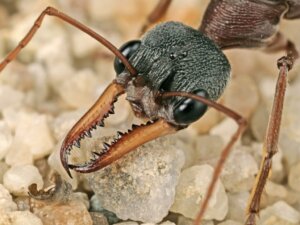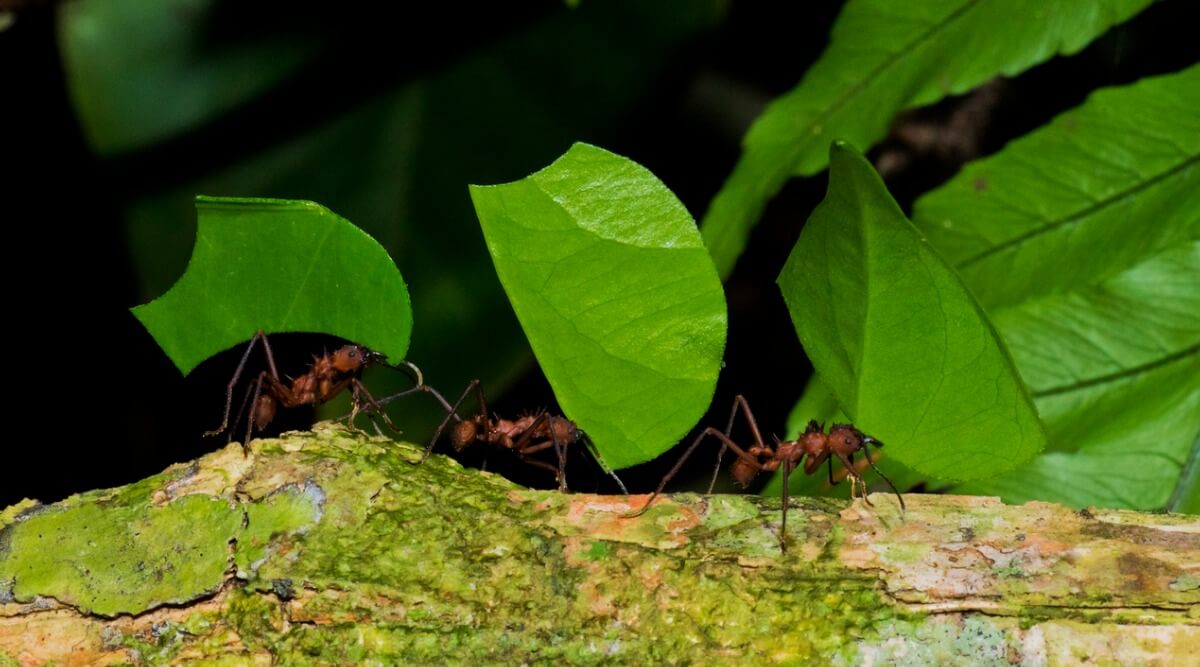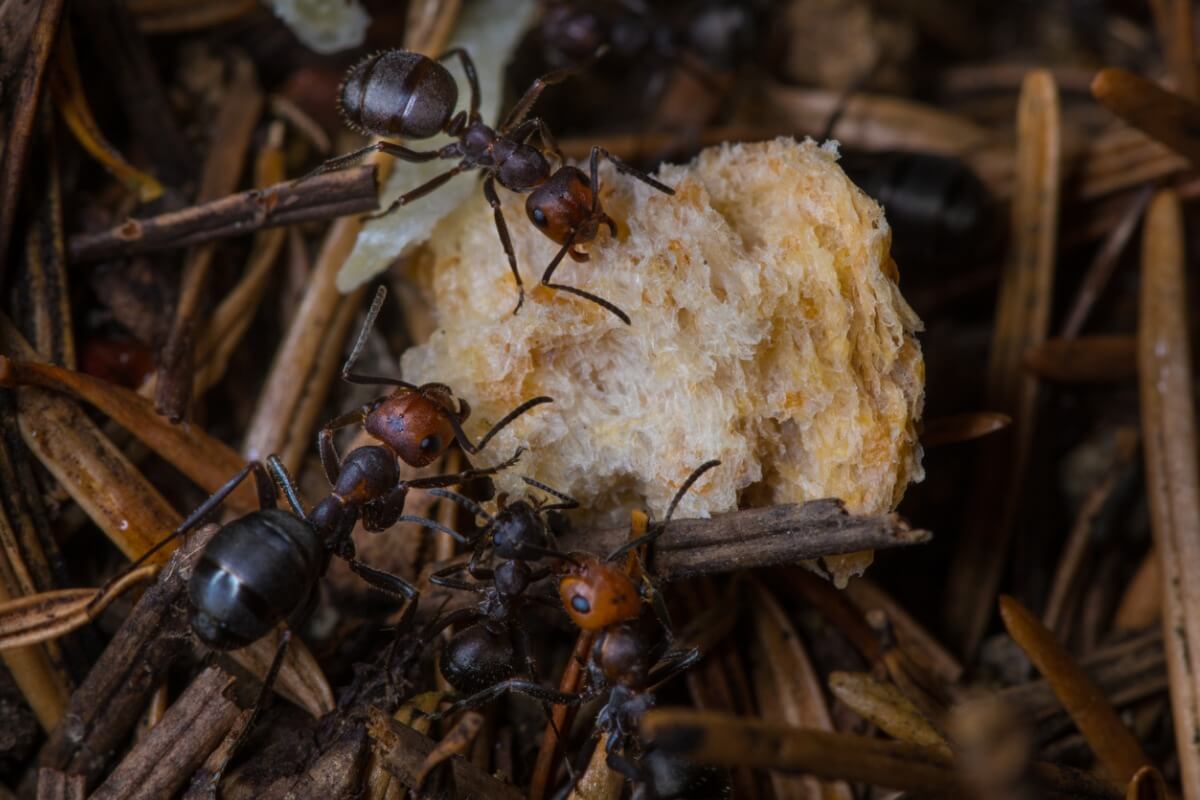The Importance of Ants in Ecosystems


Reviewed and approved by the biologist Samuel Sanchez
Ants, like all animals on planet Earth, are extremely important. They aren’t here simply because they’re an active part of an ecosystem that’s nourished by every living entity that’s a part of it. Their specific origin is a mystery – like the very origin of humanity – but phylogenetic studies are increasingly bringing us closer to definitive answers.
What we do know is that these insects date from about 90 million years ago and that they belong to the family of formicids, whose bodies have antennae and are divided into 3 sections, characterized by having a small waist. They’re related to bees and termites and it’s estimated that there are some 13,000 species distributed throughout almost the entire planet.
Another of their specific characteristics is their behavior: ants usually have only one queen, with a system of workers that maintain the community. In addition to this, they form large groups and, for many, they are pests, but this is because those people don’t know the importance of ants in the ecosystem. As we’ll see in the following article, the work of these invertebrates is priceless.
The importance of ants in ecosystems
Ants are of great importance in ecosystems, as they play a key role in their regeneration. Their fundamental role is imperceptible to the human eye, but this doesn’t mean that they’re not doing their thing day and night. They have a hierarchical organization where, as experts explain, each ant adopts a biological role.
The workers are the ones who go out to work to maintain the well-being of their community. In the task of going out in search of food, they distribute seeds, are predators of arthropods, and disperse insects in the roots of plants and trees. Access to the resources that the ants provide to the plants depends on this organization.
Some ants are soldiers, some are workers, some are males, and only one can be queen per colony. The number of chromosomes that each specimen has depends on its role.

What types of interactions do ants have with plants?
Ants have a very close relationship with plants, as they depend on them to survive. In fact, some have developed ways of attracting ants through the nectar of their flowers, stems, and thorns. Experts have argued that plants use ants to propagate their seeds and to defend them from predators.
Next, we’ll describe in a little more detail the different types of interactions that exist between plants and ants, which, in turn, help to preserve ecosystems. Don’t miss it.
Neutralism
This type of relationship doesn’t benefit or affect plants or ants. In other words, it’s a neutral way of interacting in which there are no repercussions of any kind. However, it may well be that scientists haven’t discovered the underlying mutualism.
Antagonistic
Studies have identified the antagonistic relationship as one in which the ants cut the leaves and drag the nectar or pollen from the plants, as well as removing the seeds. Specifically, this type of interaction is a negative one for the plants concerned.
Mutualists
Research affirms that the mutualistic relationship between ants and plants is one of the most fascinating fields of study in the world for naturalists and ecologists. This interaction is based on the defense that ants provide to plants.
The gain or reward for ants is their nutrition, as plants are the main basis of their diet, feeding on their nectar and waste, and serving as a shelter. On the other hand, the plants gain protection and growth, as the parasites on their surface can be preyed upon by the workers.
Importance of ants: other functions in ecosystems
As you can see, ants have different roles within ecosystems. Apart from their relationships with plants, there are others that we need to mention.
Soil modification
Soil aeration is one of the transformations that ants make possible, demonstrating their importance in ecosystems. By creating underground colonies full of galleries, tunnels, and chambers, they aerate the substrate and enrich it with the nutrients they carry from the plants and food they get.
According to research, Darwin was the first to talk about this genesis and modification of the soil in which ants participate. Without them, the biogeochemical cycles of the environments couldn’t be carried out adequately.
Organic matter degradation
Soil organic matter includes common organic components, dead roots, plant and animal residues, and decomposition products. By feeding on many of these organic components, ants contribute to their degradation.
Nutrient transport
As we have already mentioned, ants build their underground colonies from chambers and tunnels, through which they transport nutrients from plants and other food sources. Although some build their nests in trees or branches, these ‘buried cities’ are the strategy followed by most species.
In this way, there’s a benefit for the ants – who get a good diet – and another for the plants, as they take their nutrients from the same soil the colonies live in. It’s a cycle with many benefits for both of them. This is one of the examples of the mutualistic relationship that exists between both groups of living beings.

Food for other species
As studies published in the Springer Link source indicate, the mortality rate of queens before founding a colony is very high. During the nuptial flights, thousands of winged ants take to the air and take part in massive fertilization events.
This is an excellent protein source for countless birds, reptiles, amphibians, and other invertebrates, eagerly awaiting the first spring rains and subsequent ant nuptial flights. The small percentage of queens that survive this stage will found a new colony and the cycle will restart.
What happens if ants disappear?
The importance of ants is such that, if they disappeared tomorrow, global chaos would begin to brew. Ecosystems will be the main victims of the deterioration. Many plant species would become extinct, while the soils would begin to fill with insect corpses, contributing to the harmful accumulation of organic matter in the soils.
The importance of predatory ants
Solenopsis cf. Spruce is the name of one of the predatory ants, also known as ‘the bold’. According to some research, it has a wide distribution in the coffee zone of Risaralda, Colombia. Even as a predator, this ant is extremely important, as it performs essential biological control.
Although it’s a generalist and predates several species of insect pests, it has an important role to play in the agroecosystems of corn and squash in southern Mexico. This is one more reason why they mustn’t disappear, neither this species, nor any other.
There are also other ants that feed exclusively – or almost exclusively – on insects, such as those belonging to the genus Harpegnathos, Odontomachus, and Myrmecia, among others. These small hunters are essential in order to regulate the presence of other invertebrate species in small-scale ecosystems.
Some of the members of these genera, such as Myrmecia pyriformis, are considered to be the most dangerous ants in the world.

As you can see, the general image people have of ants is somewhat blurred. Some cut leaves and devastate entire crops, others kill pests due to their lethal jaws and stingers, and still others maintain functional biogeochemical cycles by returning many nutrients to the soils that would otherwise be lost.
If there’s one thing that’s clear to us after reading these lines, it’s that all endemic species in any given area are essential for the maintenance of their ecosystem. Although we don’t know all the ins and outs of the true purpose of ants, nature is wise and this has led them to survive over many centuries.
Ants, like all animals on planet Earth, are extremely important. They aren’t here simply because they’re an active part of an ecosystem that’s nourished by every living entity that’s a part of it. Their specific origin is a mystery – like the very origin of humanity – but phylogenetic studies are increasingly bringing us closer to definitive answers.
What we do know is that these insects date from about 90 million years ago and that they belong to the family of formicids, whose bodies have antennae and are divided into 3 sections, characterized by having a small waist. They’re related to bees and termites and it’s estimated that there are some 13,000 species distributed throughout almost the entire planet.
Another of their specific characteristics is their behavior: ants usually have only one queen, with a system of workers that maintain the community. In addition to this, they form large groups and, for many, they are pests, but this is because those people don’t know the importance of ants in the ecosystem. As we’ll see in the following article, the work of these invertebrates is priceless.
The importance of ants in ecosystems
Ants are of great importance in ecosystems, as they play a key role in their regeneration. Their fundamental role is imperceptible to the human eye, but this doesn’t mean that they’re not doing their thing day and night. They have a hierarchical organization where, as experts explain, each ant adopts a biological role.
The workers are the ones who go out to work to maintain the well-being of their community. In the task of going out in search of food, they distribute seeds, are predators of arthropods, and disperse insects in the roots of plants and trees. Access to the resources that the ants provide to the plants depends on this organization.
Some ants are soldiers, some are workers, some are males, and only one can be queen per colony. The number of chromosomes that each specimen has depends on its role.

What types of interactions do ants have with plants?
Ants have a very close relationship with plants, as they depend on them to survive. In fact, some have developed ways of attracting ants through the nectar of their flowers, stems, and thorns. Experts have argued that plants use ants to propagate their seeds and to defend them from predators.
Next, we’ll describe in a little more detail the different types of interactions that exist between plants and ants, which, in turn, help to preserve ecosystems. Don’t miss it.
Neutralism
This type of relationship doesn’t benefit or affect plants or ants. In other words, it’s a neutral way of interacting in which there are no repercussions of any kind. However, it may well be that scientists haven’t discovered the underlying mutualism.
Antagonistic
Studies have identified the antagonistic relationship as one in which the ants cut the leaves and drag the nectar or pollen from the plants, as well as removing the seeds. Specifically, this type of interaction is a negative one for the plants concerned.
Mutualists
Research affirms that the mutualistic relationship between ants and plants is one of the most fascinating fields of study in the world for naturalists and ecologists. This interaction is based on the defense that ants provide to plants.
The gain or reward for ants is their nutrition, as plants are the main basis of their diet, feeding on their nectar and waste, and serving as a shelter. On the other hand, the plants gain protection and growth, as the parasites on their surface can be preyed upon by the workers.
Importance of ants: other functions in ecosystems
As you can see, ants have different roles within ecosystems. Apart from their relationships with plants, there are others that we need to mention.
Soil modification
Soil aeration is one of the transformations that ants make possible, demonstrating their importance in ecosystems. By creating underground colonies full of galleries, tunnels, and chambers, they aerate the substrate and enrich it with the nutrients they carry from the plants and food they get.
According to research, Darwin was the first to talk about this genesis and modification of the soil in which ants participate. Without them, the biogeochemical cycles of the environments couldn’t be carried out adequately.
Organic matter degradation
Soil organic matter includes common organic components, dead roots, plant and animal residues, and decomposition products. By feeding on many of these organic components, ants contribute to their degradation.
Nutrient transport
As we have already mentioned, ants build their underground colonies from chambers and tunnels, through which they transport nutrients from plants and other food sources. Although some build their nests in trees or branches, these ‘buried cities’ are the strategy followed by most species.
In this way, there’s a benefit for the ants – who get a good diet – and another for the plants, as they take their nutrients from the same soil the colonies live in. It’s a cycle with many benefits for both of them. This is one of the examples of the mutualistic relationship that exists between both groups of living beings.

Food for other species
As studies published in the Springer Link source indicate, the mortality rate of queens before founding a colony is very high. During the nuptial flights, thousands of winged ants take to the air and take part in massive fertilization events.
This is an excellent protein source for countless birds, reptiles, amphibians, and other invertebrates, eagerly awaiting the first spring rains and subsequent ant nuptial flights. The small percentage of queens that survive this stage will found a new colony and the cycle will restart.
What happens if ants disappear?
The importance of ants is such that, if they disappeared tomorrow, global chaos would begin to brew. Ecosystems will be the main victims of the deterioration. Many plant species would become extinct, while the soils would begin to fill with insect corpses, contributing to the harmful accumulation of organic matter in the soils.
The importance of predatory ants
Solenopsis cf. Spruce is the name of one of the predatory ants, also known as ‘the bold’. According to some research, it has a wide distribution in the coffee zone of Risaralda, Colombia. Even as a predator, this ant is extremely important, as it performs essential biological control.
Although it’s a generalist and predates several species of insect pests, it has an important role to play in the agroecosystems of corn and squash in southern Mexico. This is one more reason why they mustn’t disappear, neither this species, nor any other.
There are also other ants that feed exclusively – or almost exclusively – on insects, such as those belonging to the genus Harpegnathos, Odontomachus, and Myrmecia, among others. These small hunters are essential in order to regulate the presence of other invertebrate species in small-scale ecosystems.
Some of the members of these genera, such as Myrmecia pyriformis, are considered to be the most dangerous ants in the world.

As you can see, the general image people have of ants is somewhat blurred. Some cut leaves and devastate entire crops, others kill pests due to their lethal jaws and stingers, and still others maintain functional biogeochemical cycles by returning many nutrients to the soils that would otherwise be lost.
If there’s one thing that’s clear to us after reading these lines, it’s that all endemic species in any given area are essential for the maintenance of their ecosystem. Although we don’t know all the ins and outs of the true purpose of ants, nature is wise and this has led them to survive over many centuries.
All cited sources were thoroughly reviewed by our team to ensure their quality, reliability, currency, and validity. The bibliography of this article was considered reliable and of academic or scientific accuracy.
- Corbara, B., Leroy, C., Orivel, J., Dejean, A., & Delsinne, T. (2019). Relaciones entre las hormigas y las plantas en los trópicos del Nuevo Mundo. Hormigas de Colombia. Universidad Nacional de Colombia, Bogotá, 203-254.
- Rico-Gray, V. (2005). Las interacciones ecológicas y su relación con la conservación de la biodiversidad. Cuadernos de biodiversidad, nº 18 (sept. 2005); pp. 3-8.
- Del Val, E., & Dirzo, R. (2004). Mirmecofilia: las plantas con ejército propio. Interciencia, 29(12), 673-679.
- Delabie, J. H. C., Ospina, M., & Zabala, G. (2003). Capítulo 10 Relaciones entre hormigas y plantas: una introducción. Introducción a las Hormigas de la Región Neotropical, 167.
- Juárez Juárez, B., Cuautle, M., Valenzuela González, J. E., & Castillo Guevara, C. (2017). Relación de la jerarquía de dominancia y abundancia en la estructura de la red de interacción planta-hormiga. Mexican journal of biotechnology, 2(1), 65-80.
- Carbonell, K. J. (2004). El mundo de las hormigas. Equinoccio.
- Rangel, J. H., & Armbrecht, I. (2007). Ciclo de vida y potencial reproductivo de la hormiga depredadora Solenopsis cf. picea (Hymenoptera: Formicidae)/Life cycle and reproductive potential of the predator ant Solenopsis cf. picea (Hymenoptera: Formicidae). Revista Colombiana de Entomología, 33(1), 64.
- López-Falcón, R. A. Materia orgánica y multifuncionalidad del suelo.
This text is provided for informational purposes only and does not replace consultation with a professional. If in doubt, consult your specialist.








